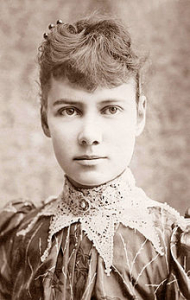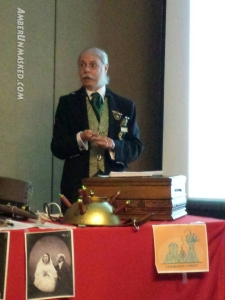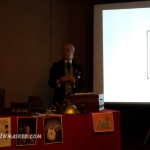STEAMPUNK WORLD’S FAIR 2015
THE VICTORIAN ASYLUM
WITH PROFESSOR VERDIGRIS WETWARE
AMBER LOVE 21-MAY-2015 Despite my personal history with mental illness and the quagmire of problems with the American healthcare-for-profit industries, I do find studies of the treatments fascinating. The character of Professor Verdigris Wetware, MS, MD, is the Medical Superintendent of the Mechanicsburg Asylum for the Wrathful & Sullen and Consultant to the County Home for the Inconvenient. He’s also the alter-ego of real life geriatric psychiatrist of Dr. Eric Brewer who uses the Professor character to give entertaining presentations on medical history such as the Victorian asylums and their progression through the early 20th century.
“Make a habit of two things: to help; or at least to do no harm.†~Hippocrates
The Professor made it clear in the beginning of his lecture that he would be using the language of day including terminology that is out of practice and bears stigma against the mentally ill. Words like mad, insane, crazy, and lunatic, never bothered me and I’m not above using them. Language evolves constantly and that can be good and bad. So, to each their own. I’m sorry if the words are upsetting.
Wetware had a ton of visual aids from a full table of photos and instruments used on patients plus a lot of slides projected during his lecture. As the meat of the material got underway, he explained that the asylums were considered the humane options since otherwise, patients would be left at home with family not able to care for them at all, or in jail. The asylums weren’t much different than jails anyway. The patients’ care consisted of shackles and chains and living in cells of various sizes. No comforts to be found anywhere. What’s particularly interesting is that during this time period (1830 – end of the Civil War), it was considered the duty of society to repair minds through taxation. So way back then, there was a socialized approach to providing care for the mentally ill; something that today is considered a tragic blow to capitalism and privatized medicine-for-profit.
Anyone who is a fan of Victorian fiction has probably noticed the frequency with which stories are set in these institutions or using mentally ill characters seen as monsters. The Professor’s theory on this is that along the way, we started to associate the unique Gothic architecture, the treatments, the patients, and the doctors with horror so it became easily adapted into the Penny Dreadful stories.
One of the slides on the projector had a lengthy list of the reasons people could be admitted to asylums. The font was too small for me to see, because the list was that long, but it included vague or benign routines like vices, immoral lifestyle, being too religious, and masturbating. Many people today are now aware of the stigma with menstruation and the hormone cycles women go through. It’s now common knowledge that a natural hormone cycle has had an intriguing medical history in the condition called “hysteria;†and, the treatment was the invention of the steam or electric powered vibrators which women would see doctors for before they became portable enough for home use. Wetware also went over an amusing list of physical characters so that the disturbed could be identified on appearance alone.

“How can a doctor judge a woman’s sanity by merely bidding her good morning and refusing to hear her pleas for release? Even the sick ones know it is useless to say anything, for the answer will be that it is their imagination.” ~Nellie Bly
The institutions began slowly improving and doctors looked at other ways to treat patients. Rather than lock them up or keep them drugged to an unrecognizable point, they started to look at diets and a practice of finding fulfilling work. They found that if patients had tasks they found rewarding, their behavior could change. This was far from the days when patients were rounded up and sat in day rooms doing nothing for the fear of excitement.
The Unitarians and the Quakers were at the root of the movement to improve the treatments. They focused on kindness and respect when others wouldn’t. Along with work, they also used art, music, and poetry which was a significant advancement and achievement. The poor who were institutionalized were exposed to arts culture for the first time.
These practitioners also took the institution’s architecture and landscaping into considering to build structures less like prisons. Wetware showed slides of some of the local facilities like Greystone in Morristown, New Jersey.
Women and men were admitted equally, but numbers showed that women were released sooner and more often; they weren’t criticized if readmitted. Men on the other hand, were seen as weak and therefore once admitted, it was nearly impossible for them to return home and receive any respect to go on with their lives. Men could lose some of their social standing and naturally, their income capabilities.
 SOURCE: http://robledo.fromthefog.com/%5B/caption%5D
SOURCE: http://robledo.fromthefog.com/%5B/caption%5D
The Professor credited women in medical history with having the biggest impacts on altering the course of treatments for the mentally ill, particularly Dorothea Dix and Nellie Bly.
Unfortunately, all the improvements that were made were lost in more recent history. Facilities became overcrowded and privatized instead of a tax burden. We lost the shared caring and civic obligation that once was there to support this population requiring holistic treatments.
“Instead of fantasizing that we can care for them, we instead fantasize that they don’t exist.†~ Prof. Wetware
The doctor behind the Professor Wetware persona is a federal employee practicing geriatric psychiatry in New York. I think it’s wonderful that he can educate people as he does in an entertaining way, but think it’s sad when people have to constantly make sure the readers, listeners, audiences know their opinions are not reflective of their employer. He never had to actually say this, but it’s in the description on the SPWF website for this lecture. I think it’s high time people are allowed to be individuals and not constantly seen as employees by virtue of a paycheck. We should be allowed to have opinions and private/social lives.
So, if you get the chance to see a lecture and notice the name Professor Verdigris Wetware, I know you’ll be entertained and educated at the same time.
For more coverage on the panels and happenings of the Steampunk World’s Fair, check out my hub of content. If you appreciate this kind of convention reporting and can support financially, please go to Patreon.com/AmberUnmasked. If you can’t contribute at this time, please consider sharing the link. Thank you!






